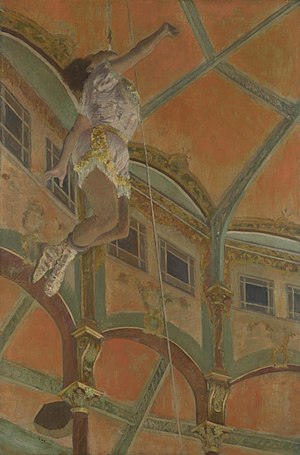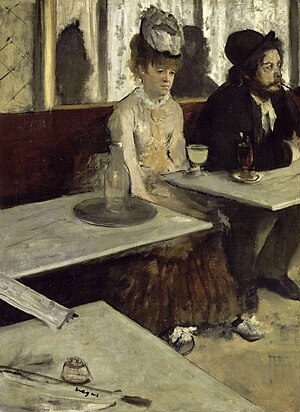
Edgar Degas (1834-1917) was a French artist famous for his paintings, sculptures, prints, and drawings. Degas seems never to have reconciled himself to the label of "Impressionist," preferring to call himself a "Realist" or "Independent." Nevertheless, he was one of the group’s founders, an organizer of its exhibitions, and one of its most important core members. Like the Impressionists, he sought to capture fleeting moments in the flow of modern life, yet he showed little interest in painting plein air landscapes, favoring scenes in theaters and cafés illuminated by artificial light, which he used to clarify the contours of his figures, adhering to his Academic training.
He is especially identified with the subject of dance; more than half of his works depict dancers. He was a superb draftsman, and particularly masterful in depicting movement, as can be seen in his renditions of dancers, racecourse subjects and female nudes. His portraits are notable for their psychological complexity and for their portrayal of human isolation.
He is especially identified with the subject of dance; more than half of his works depict dancers. He was a superb draftsman, and particularly masterful in depicting movement, as can be seen in his renditions of dancers, racecourse subjects and female nudes. His portraits are notable for their psychological complexity and for their portrayal of human isolation.
Degas' Techniques:
Degas would endlessly experiment with unusual techniques. He would sometimes mix his pastel so heavily with liquid fixative that it became amalgamated into a sort of paste. He would do a drawing in charcoal and use layers of pastel to cover part of this. He would combine pastels and oil in a single work. He would even pass through a press a heavily pigmented charcoal drawing in order to transfer the excess of pigment onto a new sheet so as to make an inverse proof of the original. In his monotypes he used etching in a new way: he inked the unetched plate and drew with a brush in this layer of ink; then he removed all the ink in places to obtain strong contrasts of light and dark or painterly effects in this printing medium. Thus, in a variety of ways Degas succeeded in obtaining a richness of surface effects.
In the 1880s, when his eyesight began to fail, Degas began increasingly to work in two new media that did not require intense visual acuity: sculpture and pastel. In his sculpture, as in his paintings, he attempted to catch the action of the moment, and his ballet dancers and female nudes are depicted in poses that make no attempt to conceal their subjects' physical exertions.
His pastels are usually simple compositions containing only a few figures. He was obliged to depend on vibrant colors and meaningful gestures rather than on precise lines and careful detailing, but, in spite of such limitations, these works are eloquent and expressive and have a simple grandeur unsurpassed by any of his other works.
Dega’s best works:
Blue Dancers (1899)


Miss La La at the Cirque Fernando (1879)

L'Absinthe (1893)

LINKS:
Though the post has few pictures, the presentation and the film make up for it!
ReplyDeleteThank, Nastya!